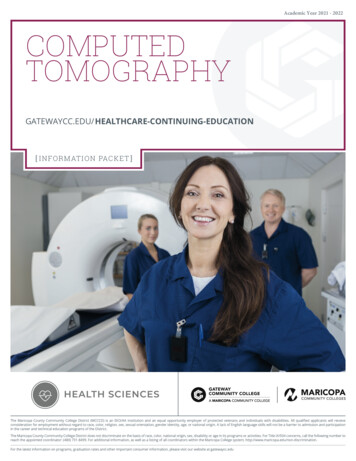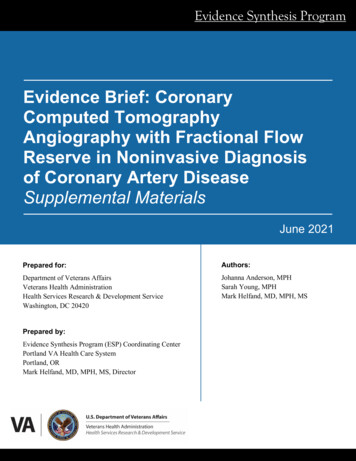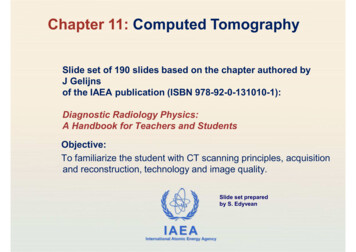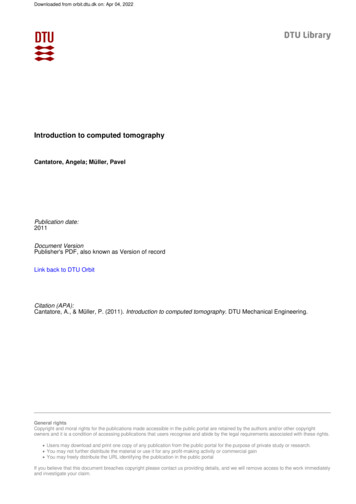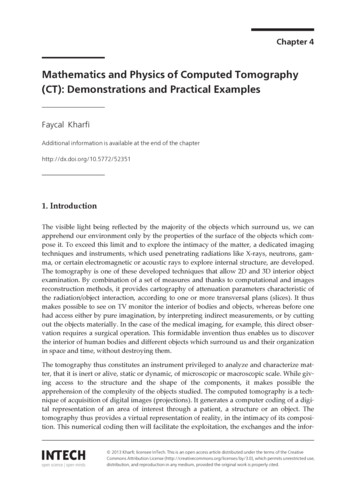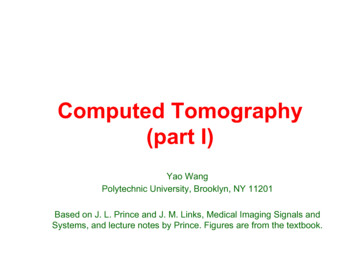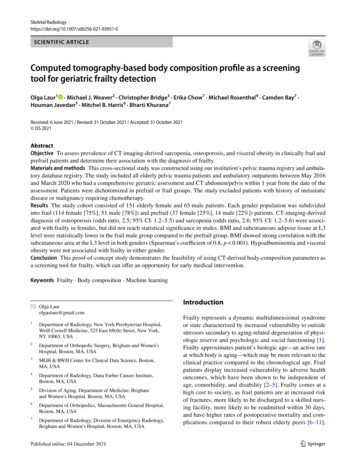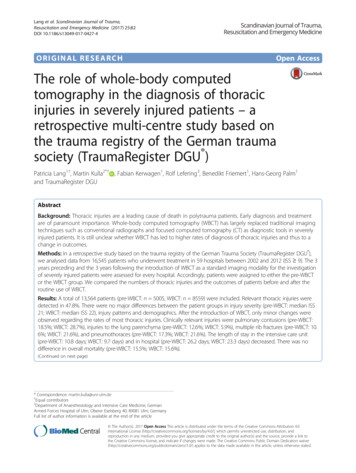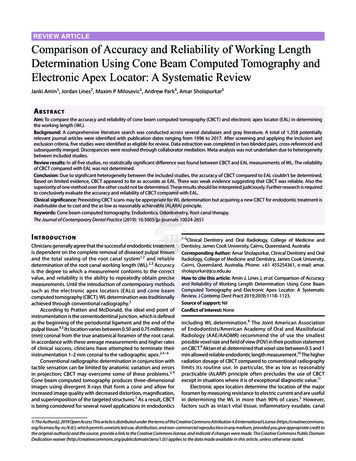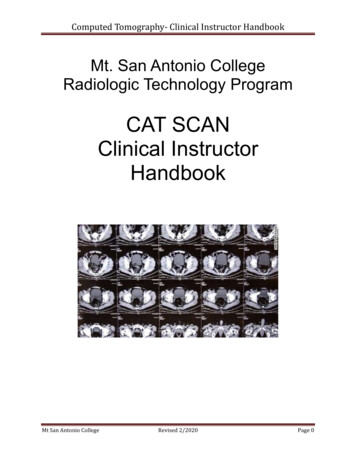
Transcription
Computed Tomography- Clinical Instructor HandbookMt. San Antonio CollegeRadiologic Technology ProgramCAT SCANClinical InstructorHandbookMt San Antonio CollegeRevised 2/2020Page 0
Computed Tomography- Clinical Instructor HandbookTable of ContentsContentPage NumberProgram Mission and GoalsProgram OverviewCT & Role of the TechnologistClinical Instructor Qualifications and DutiesPrimary Duties of Clinical StaffDirect & Indirect Supervision PolicyClinical ContractClinical Attendance PolicyClinical Attire PolicyPregnancy PolicyCollege Standard of ConductAcademic Honesty PolicyCode for Clinical ConductHonor CodeARRT Standard of EthicsProbation and Dismissal PolicyDue Process PolicyDosimetry Program & Radiation Exposure PolicyIncident Investigation ReportCT Program Radiation Safety Rules- Clinical ExperienceDrug Testing PolicyCT Clinical EvaluationRAD7A Clinical SyllabusRAD7B Clinical SyllabusTime Sheet ChecklistSample Time SheetProbation ReportStudent Injury PolicyTreatment of Student Injuries (instructions & forms)Appendix I- ARRT CT Clinical Experience RequirementsAppendix II- ARRT Instructions on Documenting ClinicalProceduresAppendix III- Sample of ARRT CT Clinical ExperienceProgress SheetAppendix IV- What is a Clinical Verifier (ARRT)Mt San Antonio CollegeRevised 42434450535657Page 1
Computed Tomography- Clinical Instructor HandbookProgram MissionThe mission of the Computed Tomography (CT) Program is to prepare competent andprofessional entry level CT Technologist. Students will be provided with a comprehensivecurriculum in the study and clinical practice of CT that addresses evolving technical skills,communication, and critical thinking. It is our goal to provide the necessary clinical andacademic experiences to enable students to successfully earn ARRT CT certification.The CT Program's mission is consistent with the College's mission in that it supportsstudents in achieving their full educational potential in an environment of academicexcellence.Program Goals1. To provide educational experiences that prepare students to enter the healthcarecommunity as CT Technologists Program curriculum will be up to date with current California statecertification educational requirements, ARRT educational requirements,and ASRT Computed Tomography curriculumClinical experience will be in compliance with California state lawProgram faculty will be qualified and meet requirements to maintainARRT credentialingProgram curriculum will maintain clinical affiliations enabling students tobecome competent entry-level CT Technologists2. To prepare clinically competent entry-level CT Technologists Students will develop workforce readiness skills Students will apply accurate positioning skills and provide appropriatepatient care Students will select optimal technical factors Students will utilize appropriate radiation protection and ALARAprinciples Students will demonstrate academic and technical competence as an entrylevel CT Technologists3. To develop CT Technologists who utilize exceptional communication skills Students will communicate effectively with patients, clinical staff, andpeersMt San Antonio CollegeRevised 2/2020Page 2
Computed Tomography- Clinical Instructor Handbook Students will demonstrate effective written and verbal communicationskills in didactic and clinical settings4. To develop CT Technologists who use critical thinking and problem-solving skills toperform job-related functions Students will use critical thinking skills in both routine and non-routineclinical situationsStudents will adapt standard procedures for non-routine patientsStudents will analyze images to determine diagnostic quality and makemodifications as needed5. To develop CT Technologists who perform CT procedures professionally Students will exhibit professional work ethic, behavior, and attitudeStudents will abide by the ASRT Code of EthicsStudents will use professional judgment when working with patients andothers6. To encourage students to invest in continued personal and professional growth Students will identify the advantage of belonging to professionalorganizationsStudents will understand the need for continued professional developmentand growthStudents will participate in professional development activities7. Students will meet the employment demands of the medical community Students will pass the ARRT certification exam in CTStudents will secure employment as a CT Technologist within one year ofprogram completionMt San Antonio CollegeRevised 2/2020Page 3
Computed Tomography- Clinical Instructor HandbookProgram OverviewThe Computed Tomography (CT) program at Mt. SAC is a two semester certificateprogram open to Technologist who possess a valid California Certified RadiologicTechnologist (CRT) license and are certified and registered by the American Registry ofRadiologic Technologists (ARRT) in one of the following supporting disciplines:Radiologic Technology, Nuclear Medicine (or NMTCB), or Radiation Therapy. Theprogram provides a complete educational experience for registered RadiologicTechnologists (RT’s) who wish to expand their skills into the study of the theory andpractice of CT. Students will have the opportunity to learn and develop competence inpatient care, communication skills, critical thinking, and technical skills that will preparethe student to become a competent entry level CT Technologist.The program curriculum is designed to meet the CT educational and clinical trainingrequirements set forth by the ARRT. The educational standards established by theAmerican Society of Radiologic Technologists (ASRT) are also incorporated into thecurriculum. Educational activities include lecture, discussions, group activities, andhands-on clinical training at a clinical site.The program includes: ARRT clinical experience requirements and content specificationsARRT 16 hour structured education requirementCourse work in cross-sectional anatomy, pathology, patient care and safety, CTprocedures, equipment, image evaluation, instrumentation, technique, physics,and quality assurance/quality control.The program is completed during Winter and Spring semesters (22 weeks). Didacticcourses are scheduled two - four days per week and require the student to be on campus.Clinical training will be conducted at affiliated healthcare institutions and there is noguarantee the student will be placed close to home. Hours for clinical training arearranged with the clinical site (days and times will vary depending on the site). Noarrangements for part time status are available.Applicants will be required to complete a background check, physical, drug test andprovide proof of immunizations during the admissions process. For more information onthose requirements please contact Paulette Engisch at pengisch@mtsac.edu or (909) 4274527.Upon successful completion of the program, the student will receive a Certificate ofCompletion from Mt. San Antonio College. Technologist certified and registered byARRT in the appropriate disciplines will be eligible to sit for the ARRT ComputedTomography certification examination.Mt San Antonio CollegeRevised 2/2020Page 4
Computed Tomography- Clinical Instructor HandbookComputed Tomography & Role of the CT TechnologistComputed Tomography (CT) is a sophisticated diagnostic imaging modality that capturescross- sectional images of the patient utilizing ionizing radiation and a computer. CT canbe used to image many parts of the body, such as the head, neck, chest, abdomen, pelvis,spine, and extremities. CT plays a vital role in diagnosing trauma patients.CT Technologists are highly-trained professionals who work with specialized x-rayequipment to produce diagnostic images of the body that will assist the radiologist indiagnosis and treatment of disease and injury. Technologists also ensure the safety andwell-being of the patient. It is essential that the CT Technologist be knowledgeable inanatomy, can make judgments about the formation of the image, and be able to performCT procedures in an efficient and competent manner. CT Technologists work closelywith patients, fellow technologists, radiologists, and many members of the healthcareteam. Professional duties include providing quality patient care, operating sophisticatedequipment, performing routine & emergency procedures, recording a patient’s clinicalhistory, preparing patients for procedures, evaluating images for technical quality,assisting with interventional procedures, observing radiation protection measures,processing/reconstruction of images, and participating in quality assurance measures.Clinical Instructor Qualifications & DutiesPrimary Qualifications of the Clinical Instructor1. Must hold American Registry of Radiologic Technologists current registration inradiography or equivalent (i.e., unrestricted CRT state license).2. Must have 2 years full time experience in the professional discipline;3. Must understand the clinical objectives and the evaluation system;4. Must be knowledgeable of program goals;5. Must be proficient in student supervision, instruction, and evaluation; and6. Must maintain competency in the discipline and clinical instruction throughcontinuing education, in-service training and/or the pursuit of advancedcertifications and/or degrees.Primary Duties of the Clinical Instructor1.2.3.4.5.6.Is knowledgeable of program goals;Understands the clinical objectives and clinical evaluation system;Understands the sequencing of didactic instruction and clinical education;Provide students with clinical instruction and/or supervision;Evaluates students’ clinical competence;Maintains competency in the professional discipline and instructional andevaluative techniques through continuing professional development;7. Maintains current knowledge of program policies, procedures, and studentprogress;Mt San Antonio CollegeRevised 2/2020Page 5
Computed Tomography- Clinical Instructor Handbook8. Provides students with an orientation to the clinical setting policies andprocedures in regard to health and safety;9. Participate in the assessment of the student’s progress with College Facultyduring scheduled clinical facility visitations;10. Attends Advisory Meetings and/or CI Workshops as deemed necessary by thesponsoring institution; and11. Informs the clinical staff of the JRCERT clinical staff requirements (see below).12. Acts as Clinical Verifier for CT student (see Appendix IV)Primary Duties of the Clinical Staff1.2.3.4.Understand the clinical competency system;Understand requirements for student supervision;Supports the educational process; andMaintains current knowledge of program policies, procedures, and studentprogress.5. Acts as Clinical Verifier for CT student (see Appendix IV)Clinical education shall be under the direct or indirect supervision of a qualifiedpractitioner as the situation dictates, to ensure control of the quality, safety, andtechnical aspects of radiographic examinations and procedures in the clinical facility.Mt San Antonio CollegeRevised 2/2020Page 6
Computed Tomography- Clinical Instructor HandbookDirect & Indirect Supervision PolicyState and federal regulations require that programs ensure students are properlysupervised while performing medical imaging procedures in the clinical setting. Thefollowing direct and indirect supervision requirements assure patient safety and propereducational practices.Direct SupervisionCT procedures must be performed under the direct supervision of a qualifiedradiographer until a student achieves competency and any time a student is repeatingunsatisfactory images/procedure.The program defines direct supervision as student supervision by a qualified radiographerwho: reviews the procedure in relation to the student’s achievement, evaluates the condition of the patient in relation to the student’s knowledge, is physically present during the conduct of the procedure, reviews and approves the images/procedure, and approves the student’s procedure prior to re-exposure on repeat exams.Indirect SupervisionCT procedures may be performed under the indirect supervision of a qualifiedradiographer after a student achieves competency.The program defines indirect supervision as that supervision provided by a qualifiedradiographer who: is immediately available to assist students regardless of the level of studentachievement.“Immediately available” is interpreted as the physical presence of a qualifiedradiographer adjacent to the room or location where a radiographic procedure is beingperformed. This availability applies to all areas where ionizing radiation equipmentis in use on patients.Students violating this policy will be subject to probation and expulsion from theprogram. Complying with the policy is the student’s responsibility.Mt San Antonio CollegeRevised 2/2020Page 7
Computed Tomography- Clinical Instructor HandbookClinical Contract for Mt. San Antonio College CT ProgramStudents entering the clinical internship are expected to fulfill the following requirements:1.2.3.4.5.Students may not attend clinical unless the student has registered and paid for each clinicalcourse. ()Students must wear a radiation film badge to clinical at all times. Students who present to clinicalwithout a badge cannot participate in training and will need to make up the hours missed. ()Students must read and understand the Radiation Exposure Policy, and the indications forpreparing an Incident Investigation Report. ()Students must review, sign, and date the Radiation Exposure Report posted in the classroomeach month. ()Students must comply with Attendance Policy () including the following:a.b.All clinical hours missed, must be made up before the end of each session. ()All make up hours must be made up during college business hours only. See Clinicalattendance policy for details. ()c. All schedule changes need to be approved by the program faculty and documentationmust be submitted. ()d. Make up hours cannot be made up during official college holidays. ()e. Students must complete the required number of clinical hours per session.()f. No vacation or time off is allowed during clinical internship. ()g. “Banking hours” (defined as making up hours before the absence) is not allowed.()h. Students must fill out an absence/make up form and submit the form to a programfaculty member within 3 days of the absence (weekends do not count). ()6.7.8.9.10.11.12.13.Students must earn 2 passing Clinical Evaluations in the Spring Semester and 1 passing ClinicalEvaluation in the Winter intersession. ()Students must complete the number of required competencies per session. See course syllabus fordetails. ()Students must comply with the Clinical Attire Policy ()No cell phone use (including texting) is allowed during clinical hours. ()Students are required to submit clinical handbooks after each session. ()Students must maintain professional and ethical behavior at all times. See the Clinical Code ofConduct for specific examples. ()Students need to be current with physicals, immunizations, and CPR requirements to attendclinical. Students who are not current will be removed from clinical immediately and hours willneed to be made up. ()Students are responsible for ensuring all required paperwork (including physicals, CPR, drugtesting, etc.) is submitted to the Clinical Coordinator before or on the date specified. Follow up isalso necessary to assure clearance for clinical rotations.()Mt San Antonio CollegeRevised 2/2020Page 8
Computed Tomography- Clinical Instructor HandbookClinical Attendance PolicyThe following attendance requirements apply to RAD 7A and RAD 7B Students must attend all required clinical hours. Clinical hours are arranged by the clinicalinstructor/site and may be scheduled between the hours of 6:30am-10pm Monday- Sunday.oRAD 7A requires 18 hours/week of arranged clinical hoursoRAD 7B requires 24 hours/week of arranged clinical hoursoModifying clinical schedule: Approval from the program’s clinical coordinator and theclinical facility’s clinical instructor is required in writing prior to any change in a student’sscheduled clinical hours. Clinical hours may be modified with mutual approval of allparties. Students subverting this process by making arrangements with clinical siteswithout prior approval from the college faculty will be subject to probation and dismissalfrom the program. Clinical hours must be logged on the clinical time sheet provided in the clinical handbook for eachclinical course. The student is responsible for obtaining the clinical instructor’s signature verifyingthe hours completed for the semester. Clinical handbooks must be turned in to the clinicalcoordinator to pass the course. Time sheets will be filed in the department for 5 years in compliancewith state regulations. Students shall not attend clinical unless he/she has enrolled and paid for the course. Students shall not participate in more than 10 hours per day of clinical training. No personal vacations or time-off are allowed during scheduled clinical courses. Banking hours (making up hours before the absence) is not allowed. AbsencesoAn absence/incident is described as an occurrence of non-attendance. (Ex: if a student isabsent one day one absence. If a student is absent three days in a row for an illness one incident. One extended illness will not place the student on probation). A tardy occurswhen a student is more than six (6) minutes late.oTardies of more than six (6) minutes are to be made up with time equal to the amount oftime lost due to the tardy.oIf a student is late or absent, the student must call his or her clinical instructor before thetardy/absence occurs. The student should make every effort to speak directly with theclinical instructor (messages left with others may not be conveyed as expected).oHours must be made up when the college is open (6:30 a.m- 10:00 p.m., Monday throughSunday). The college is closed on holidays (see the academic schedule for observedholidays).Mt San Antonio CollegeRevised 2/2020Page 9
Computed Tomography- Clinical Instructor HandbookoAll absences/tardies must be made up at the clinical facility where the absence occurredand within the applicable semester or inter-session (Not to exceed 10 hours per day ofclinical training, and the total didactic and clinical involvement shall not exceed 40 hoursper week. Hours exceeding these limitations due to making up of clinical hours must bevoluntary on the student’s part).oIn the event of an absence, the student is responsible for completing an Absence/MakeupForm and submitting it to the Clinical Coordinator or faculty member within 3 days ofthe absence. If the attendance policy is exceeded before the last day to drop with a “W,” a grade of “W” will beassigned. If the policy is exceeded after the last day to drop with a “W,” a grade of No Pass (NP)will be assigned. In the event of extenuating circumstances (ex. jury duty, court subpoena), the program reserves theright to make arrangements with the student. The faculty member and clinical instructor must meetwith the student to discuss the circumstance and determine a possible solution.RAD 7ARAD 7B2 absences/incidents or tardies will necessitateprobation status3 absences/incidents or tardies will necessitateprobation status3 absences/incidents or tardies will necessitate nocredit (NC) for the course due to the inability of thestudent to complete the course objectives. Thestudent will not be able to continue in the clinicalportion of the program.4 absences/incidents or tardies will necessitate nocredit (NC) for the course due to the inability of thestudent to complete the course objectives. Thestudent will not be able to continue in the clinicalportion of the program.Mt San Antonio CollegeRevised 2/2020Page 10
Computed Tomography- Clinical Instructor HandbookClinical Attire PolicyCT program students are required to adhere to the clinical attire policy and present anoverall professional appearance while at the clinical education center. Non-compliancewith the clinical attire policy will be recorded on the student’s clinical evaluation form andthe student will be placed on probation.All Students: Scrub type tops and pants only: No other variations (skirt, shorts) are allowed. Scrubs must beof proper size, kept clean, and wrinkle free.Lab coat: A white, short or long sleeve lab coat may be worn over the attire if desired.Long sleeve shirts: May be worn under scrub tops. Shirt must be a solid color (black, grey, andwhite only), with no type of print, and must be tucked in and not visible below the scrub top.Shoes: Must be white or black athletic/tennis shoes or uniform shoes that can repel liquids, bodyfluids, etc . No open-toe shoe, sandals, and shoes with holes may be worn at any time.Socks: Must be worn with shoes at all times.Name badge: Provided by college free of charge. If the facility provides the student with ahospital name badge, the student will not be required to wear both name badges. The student willneed to return their hospital badge to the facility once their clinical rotation is over.Tattoos: Must not be visible at any time.Body piercings: Must not be visible at any time.Earrings: Must be small, not dangling.Ear plugs/expanders: Must be covered with a band-aid.Fingernails: Acrylic fingernails, long fingernails, and chipped fingernail polish are not allowed.Personal hygiene: Must maintain personal cleanliness to include mouth and body odor.Fragrances, perfumes, aftershaves, & colognes: Excessive use is not permitted.Make up & hairstyles: No excessive make-up or radical hairstyles are allowed.Jewelry: No excessive jewelry is allowed. (1 ring/ 1 bracelet/1 watch is permitted)Electronic devices: Use of electronic devices (e.g., cell phone, smart watch, ipad) is not allowedin clinical areas at any time. Devices may be used during designated breaks and lunch time only.Men: Earrings: Must not to be worn at any time.Hair: May be collar length maximumFacial hair: Mustaches, sideburns, and beards of any kind need to be kept neat and closelytrimmed to the face.If the clinical facility’s dress code is more restrictive than the Program’s Clinical AttirePolicy, the hospital code will supersede. All uniforms are subject to instructorapproval.Mt San Antonio CollegeRevised 2/2020Page 11
Computed Tomography- Clinical Instructor HandbookPolicy for Declared Pregnant Radiography StudentsDisclosure of a pregnancy by a radiography student or faculty member is a voluntary process. Thestudent or faculty member is not under any regulatory or licensing obligation to declare the pregnancy.For the purpose of this document, the term worker includes program students and faculty working incontrolled areas. The voluntary declaration of pregnancy, if made, must be in writing, dated, include theestimated date of conception, and be submitted to the Radiation Safety Officer (RSO). Thisdocument will become a permanent part of the worker’s record. Just as a woman has the right to declare her pregnancy, she also has the right to revoke thedeclaration. The written withdrawal of declaration shall be submitted to the RSO. Pregnant workers have the option for continuance in the program without modification ofclinical duties.The program strongly recommends that workers voluntarily declare pregnancy so an additional radiationmonitoring device may be issued and worn at waist level. Fetal radiation monitoring devices are simplyadded precautions and do not in any way convey any assignment in the clinical facility is especiallyhazardous during pregnancy. The RSO will maintain documentation of radiation doses for the pregnantworker and embryo/fetus. The radiation dose to the embryo/fetus during the entire pregnancy will not beallowed to exceed 0.5rem (5mSv).*Pregnant workers shall not expect the issuance of a fetal radiation monitoring device unless thepregnancy has been declared by the worker.Pregnant students enrolled in CT Program clinical courses (RAD 7A & RAD7B) are encouraged toconsult their personal physician regarding pregnancy and any potential risk to the embryo/fetus.Declared pregnant workers will receive and discuss the following with the RSO: Nuclear Regulatory Commission’s “Occupational Dose Limits, Sec.20.1208, Dose to theEmbryo/Fetus.”The United States Nuclear Regulatory Commission Guide 8.13 Instruction Concerning PrenatalRadiation ExposureThe United States Nuclear Regulatory Commission Guide 8.29 Instruction Concerning Risksfrom Occupational Radiation ExposureA student who voluntarily withdraws from the program due to pregnancy must provide a writtenwithdrawal letter. A student may be readmitted during the appropriate semester provided (1) the studentwas in “good standing” at the time of withdrawal, and (2) the intent to re-enter the program is conveyedduring the semester prior to the student’s anticipated return.During the completion of the coursework, the declared pregnant student shall meet all regular attendancerequirements.It is agreed and understood that student shall indemnify and hold harmless Mt. San Antonio College, its GoverningBoard, employees and agents from and against any and all liability, loss, cost, expense (including reasonableattorneys’ fees) or claim for injury or damages to student and/or student's embryo/fetus arising out of clinicalassignment to a radiation area in connection to courses in the CT Program; excluding however liability, loss, cost,expense or claim attributed to the negligent acts or omissions of Mt. San Antonio College, its Governing Board,employees and agents in connection to the clinical assignment.Mt San Antonio CollegeRevised 2/2020Page 12
Computed Tomography- Clinical Instructor HandbookStudent Conduct & Disciplinary ProceduresCollege Standards of ConductThe following conduct shall constitute good cause for discipline, including but not limited to the removal,suspension or expulsion of a student. Causing, attempting to cause, or threatening to cause physical injury to another person.Possession, sale or otherwise furnishing any firearm, knife, explosive or other dangerous object, includingbut not limited to any facsimile firearm, knife or explosive, unless, in the case of possession of any objectof this type, the student has obtained written permission to possess the item from a College employee,which is concurred in by the College President/CEO.Unlawful possession, use, sale, offer to sell, or furnishing, or being under the influence of, any controlledsubstance listed in Chapter 2 (commencing with Section 11053) of Division10 of the California Health and Safety Code, an alcoholic beverage, or an intoxicant of any kind; orunlawful possession of, or offering, arranging or negotiating the sale of any drug paraphernalia, as definedin California Health and Safety Code Section 11014.5.Committing or attempting to commit robbery or extortion.Causing or attempting to cause damage to College property or to private property on campus.Stealing or attempting to steal College property or private property on campus, or knowingly receivingstolen College property or private property on campus.Willful or persistent smoking in any area where smoking has been prohibited by law or by regulation of theCollege.Committing sexual harassment as defined by law or by College policies and procedures.Engaging in harassing or discriminatory behavior based on disability, gender, gender identify, genderexpression, marital status, nationality, race or ethnicity, religion, sexual orientation, or any other statusprotected by law.Engaging in intimidating conduct or bullying against another student through words or actions.Willful misconduct which results in injury or death to a student or to College personnel or which results incutting, defacing, or other injury to any real or personal property owned by the College or on campus.Disruptive behavior, willful disobedience, habitual profanity or vulgarity, or the open and persistentdefiance of the authority of, or persistent abuse of, College personnel.Cheating, plagiarism (including plagiarism in a student publication), or engaging in other academicdishonesty.Dishonesty; forgery; alteration or misuse of College documents, records or identification; or knowinglyfurnishing false information to the College.Unauthorized entry upon or use of College facilities.Lewd, indecent or obscene conduct on College-owned or controlled property, or at College sponsored orsupervised functions.Engaging in expression which is obscene; libelous or slanderous; or which so incites students as to create aclear and present danger of the commission of unlawful acts on College premises, or the violation of lawfulCollege administrative procedures, or the substantial disruption of the orderly operation of the College.Persistent, serious misconduct where other means of correction have failed to bring about proper conduct.Unauthorized preparation, giving, selling, transfer, distribution, or publication, for any commercialpurpose, of any contemporaneous recording of an academic presentation in a classroom or equivalent siteof instruction, including but not limited to handwritten or typewritten class notes, except as permitted byany College policy or Administrative Procedure.Mt San Antonio CollegeRevised 2/2020Page 13
Computed Tomography- Clinical Instructor Handbook Harassment of students and/or College employees that creates an intimidating, hostile, or offensiveenvironment.Violation of College rules and regulations including those concerning affiliate clubs and organizations, theuse of College facilities, the posting and distribution of written materials, and College safety procedures.Academic Honesty PolicyAll members of the academic community have a responsibility to ensure that scholastic honesty ismaintained. Faculty have the responsibility of planning and supervising all ac
The Computed Tomography (CT) program at Mt. SAC is a two semester certificate program open to Technologist who possess a valid California Certified Radiologic Technologist (CRT) license and are certified and registered by the American Registry of Radiologic Technologis
